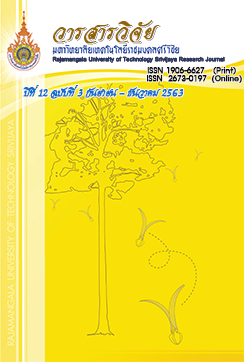Solar Refrigerator Prototype
Keywords:
refrigerator, solar energy, renewable energyAbstract
This paper presented the design of a solar refrigerator of approximate 0.4 × 0.33 × 0.54 meters for preserving fresh food by receiving electrical energy from the solar system. This was to explore suitable energy efficiency for refrigerating between the refrigerating system with and without PID control. The efficiency was analyzed from five types of vegetables, namely cucumber, eggplant, bell pepper, raw tomato, and ripe tomato. These vegetables needed to be stored at 8-10 degrees Celsius and this experiment employed 8 degrees Celsius temperature. The results of the research showed that the refrigerating system without PID control uses a voltage of 11.29 volts and a current of 0.40 amperes that was equal to the electric power of 4.59 watts. The refrigerating system with PID control uses a voltage of 10.14 volts and a current of 0.27 amperes that was equal to the electrical power of 2.74 watts. This showed that energy consumption of the system with PID control was less than 36.93 % of without PIC control. The best time for energy storage of the solar system was around 14.30 p.m. with a light intensity of 32500 lux and a power of about 65 watts. The 60 ampere-hour batteries storing power in eight hours were able to store total electricity power of 580.53 watts or the current of 48.37 amperes that was enough to use refrigerator for a day. This was also able to develop more efficient solar refrigerator in the future. In addition to the solar energy, refrigerator with the PID control system can apply to other alternative energy for more efficiency such as wind power and water power.
References
ตระการ ก้าวกสิกรรม. 2555. การทำความเย็นตอนที่ 2-3 อุปกรณ์ทำความเย็นแบบอัดไอ. วารสารเทคนิค เครื่องกล ไฟฟ้า อุตสาหการ 21(238): 136-144.
ทนงเกียรติ เกียรติศิริโรจน์. 2559. ระบบระบายความร้อนด้วยอากาศในเซลล์แสงอาทิตย์เพื่อเพิ่มประสิทธิภาพในการผลิตกําลังไฟฟ้า. สํานักงานพัฒนาวิทยาศาสตร์และเทคโนโลยีแห่งชาติ. แหล่งที่มา: https://www.nnr.nstda.or.th/website/attachments/article/1034/10-Solarพลังงานแสงอาทิตย์.pdf, 14 ธันวาคม 2559.
นพดล รุ่งสวาท. 2557. การออกแบบระบบผลิตไฟฟ้าจากเซลล์แสงอาทิตย์. ส่วนวิชาการวิศวกรรม สำนักส่งเสริม และพัฒนางานเทคนิค กรมประชาสัมพันธ์. แหล่งที่มา: https://hq.prd.go.th/engineer/download/article/article_20150720153823.pdf, 28 มีนาคม 2557.
บุญเลิศ สงวนวัฒนา. 2551. การศึกษาตู้เย็นไฟฟ้าใช้พลังงานแสงอาทิตย์. วารสารมหาวิทยาลัยราชภัฎกำแพงเพชร 14(2): 59-68.
ปฐมพงค์ จิโน, ถิรายุ ปิ่นทอง และ โกเมน หมายมั่น. 2557. การศึกษาระบบทําน้ำร้อนและน้ำเย็นด้วยเทอร์โมอิเล็กทริกส์ ร่วมกับโซล่าเซลล์. วารสารวิทยาศาสตร์บูรพา 19(3): 231-243.
วโรดม ตู้จินดา. 2550. การออกแบบระบบควบคุม. สำนักพิมพ์มหาวิทยาลัยเกษตรศาสตร์, กรุงเทพฯ.
สุลักษณา มงคล และ ปริญา คงกระพันธ์. 2558. ห้องเย็นเก็บผลผลิตทางการเกษตร. การจัดการพลังงานในภาคเกษตรกรรม วิทยาลัยพลังงานทดแทน มหาวิทยลัยแม่โจ้. แหล่งที่มา: http://readgur.com/doc/2105408/วิชา-พง-424-การจัดการพลังงานในภาคเกษตรกรรม, 15 พฤษภาคม 2558.
Akinola, A.O., Mogaji, T.S. and Adewole, K.A. 2015. Development of Solar-Powered Mobile Refrigerator. International Journal of Emerging Technology and Advanced Engineering 5(9): 1-6.
Ekren, O, Yilanci, A., Cetin, E. and Ozturk, H.K. 2011. Experimental Performance Evaluation of A Pv-Powered Refrigeration System. Electronics and Electrical Engineering 8(114): 7-10.
Downloads
Published
How to Cite
Issue
Section
License
The content and information in the article published in Journal of Rajamangala University of Technology Srivijaya It is the opinion and responsibility of the author of the article. The editorial journals do not need to agree. Or share any responsibility.







